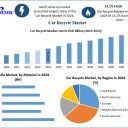
Car recycling contains reusing restored parts and shredding and recycling car materials like plastics, aluminums, and steel. End-of-life vehicles are crushed in recycling plants to eliminate parts and hence crushed to recuperate materials.
Global Car Recycle Market to Reach USD 286.32 Billion by 2032 Driven by Sustainability Initiatives and Rising End-of-Life Vehicle VolumeThe Global Car Recycle Market was valued at USD 99.67 billion in 2024 and is expected to expand at a robust CAGR of 14.1% from 2025 to 2032, reaching nearly USD 286.32 billion by 2032. Growing emphasis on sustainability, rising automotive waste management regulations, and increasing demand for recycled metals and plastics are fueling the rapid expansion of the global car recycling industry.
Car Recycle Market Overview
Car recycling involves the recovery and reuse of valuable materials—such as steel, aluminum, copper, and plastics—from end-of-life vehicles (ELVs). The process typically includes dismantling, crushing, shredding, and material recovery, ensuring that reusable parts and materials are extracted efficiently. With automobiles achieving a recycling rate of nearly 80%, the industry stands as one of the most mature and sustainable sectors in global recycling.
Over 18 million tons of steel are recovered annually from scrapped vehicles, demonstrating the crucial role of car recycling in circular economy initiatives. Advanced separation technologies such as eddy current, laser, infrared, and flotation methods are increasingly used to enhance the purity and efficiency of recycled materials.
Access your free report sample — uncover the top-performing segments today@ https://www.maximizemarketresearch.com/request-sample/52805/" target="_blank"> https://www.maximizemarketresearch.com/request-sample/52805/
Car Recycle Market Dynamics
Key Drivers
Government Regulations and Environmental Mandates:
Governments across major economies—including the U.S., Japan, and EU nations—have introduced stringent policies promoting automotive waste recycling and reducing dependency on virgin materials. For example, the U.S. imposes heavy duties on imported virgin steel, pushing automakers to incorporate more recycled metals.
Sustainability and Energy Savings:
Recycling steel and aluminum requires significantly less energy than producing virgin materials, leading to reduced greenhouse gas emissions and conservation of natural resources. Each year, automotive recycling prevents millions of gallons of hazardous fluids from contaminating the environment.
Rising End-of-Life Vehicles (ELVs):
With more than 27 million vehicles reaching end-of-life annually, the supply of recyclable materials continues to grow. Urbanization and increased vehicle ownership further accelerate the demand for structured recycling solutions.
Technological Advancements:
The emergence of automated dismantling systems and advanced material recovery technologies is improving recycling efficiency. Industry innovations such as Green Recycled Parts (GRP) by the Automotive Recyclers Association (ARA) are promoting quality-certified recycled components.
Restraints
The major challenge lies in plastic recycling, given the complexity of separating and processing various polymers used in vehicle interiors and components. However, advancements in plastic sorting and chemical recycling are gradually mitigating this limitation.
Car Recycle Market Segment Analysis
By Material
Metals (Iron, Aluminum, Steel, Copper) dominate the market, driven by the high value of recycled steel and the widespread use of aluminum in modern lightweight vehicles.
Rubber is gaining traction due to recycling applications in tire manufacturing and road construction.
Plastics and Glass segments are projected to grow steadily as new technologies make recycling economically viable.
By Type
Passenger Car Recycling holds the largest share and is projected to grow at the fastest rate. Government policies phasing out older, high-emission vehicles have significantly boosted recycling volumes in this segment.
Commercial Vehicle Recycling is also expanding, supported by logistics and transportation sector modernization.
Regional Insights
North America leads the global market, with the U.S. hosting over 100,000 recycling-related jobs. The country boasts the highest automotive recycling rate globally, supported by mature infrastructure and favorable regulations.
Europe follows closely, with strong participation from recycling giants like Scholz Recycling GmbH and European Metal Recycling (EMR). EU directives promoting circular economy initiatives continue to propel the market.
Asia Pacific is emerging as a key growth hub, driven by high vehicle production volumes in China, India, Japan, and South Korea. Although recycling rates remain lower compared to Western nations, government-led sustainability initiatives are rapidly improving regional capabilities.
Middle East, Africa, and South America are gradually adopting structured recycling frameworks as urbanization and vehicle ownership rise.
Access your free report sample — uncover the top-performing segments today@ https://www.maximizemarketresearch.com/request-sample/52805/" target="_blank"> https://www.maximizemarketresearch.com/request-sample/52805/
Competitive Landscape
The global car recycling market is moderately consolidated, with a mix of multinational corporations and regional recyclers. Key players focus on technological innovation, sustainable recovery processes, and strategic collaborations with automakers.
Major Companies:
Scholz Recycling GmbH
Schnitzer Steel Industries, Inc.
Sims Metal Management Limited
Hensel Recycling Group
INDRA
Keiaisha Co., Ltd.
LKQ Corporation
Toyota Motor Corporation
Eco-Bat Technologies Ltd
European Metal Recycling (EMR)
Tianqi Automation Engineering Co., Ltd. (Miracle Automation)
ASM Auto Recycling Ltd Inc
These companies are actively investing in automated dismantling, digital inventory management, and circular economy partnerships to improve efficiency and sustainability.
Conclusion
The Global Car Recycle Market is transitioning into a cornerstone of the sustainable automotive ecosystem. As automakers embrace eco-friendly materials and governments push for zero-waste policies, the demand for efficient and advanced car recycling processes will continue to accelerate. By 2032, the industry is expected to play a central role in reducing environmental impact, conserving resources, and supporting global circular economy objectives.






 supriyamaximize
supriyamaximize
 b1giptv
b1giptv